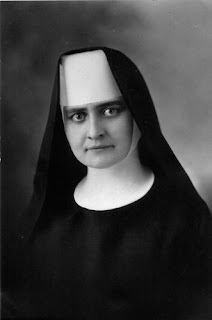As we hit summer with soaring temperatures, our skin can take a beating from the sun and insects. For myself I would rather have pain than an itch. I am reminded of this holy nun of our order who suffered much, and gave it all for others.
SERVANT of GOD SISTER MARY ANNELLA ZERVASwas born inMoorhead , Minnesota St. Joseph , Minnesota
SERVANT of GOD SISTER MARY ANNELLA ZERVASwas born in
Her father, immigrant from the village of Immekeppel, Germany Quebec
Anna was raised as part of a large family which attended St. Mary's Roman Catholic Church in Moorhead St. Joseph
Hubert and Emma Zervas were reportedly very reluctant to part with their daughter at such a young age. Father Alfred, however, advised them, "Don't put anything in her way; she is not too young to give herself to God." Hubert Zervas wrote several years later that he and his wife had then "gladly consented to give back the child to Him from Whom they had received her."
Anna entered Saint Benedict's Monastery as a postulant in 1915 and entered the novitiate in 1918. She was remembered as a quiet and unassuming nun who was fond of reading The Following of Christ by Geert Groote.
In 1918, she received the habit in a ceremony conducted by Bishop Joseph Francis Busch of St. Cloud , Minnesota
Anna rushed to tell her parents her new religious name, Sister Mary Annella. Her mother remarked, not unkindly, 'But there is no Saint Annella,' to which Sister Annella, concealing her slight disappointment at this reaction to the name by which she would henceforth be known, replied, 'Then I shall have to be the first one!'" She took her final vows in 1922 and was assigned as a music teacher and organist to St. Mary's Convent in Bismarck , North Dakota
During the summer of 1923, Sister Annella noticed a small reddish brown patch on her arm which itched terribly. Despite attempts to quietly bear the disease, the spreading rash soon proved impossible to conceal and soon covered the majority of her body.
In April 1924, her parents were summoned to her hospital bedside. When her mother reached the door, she looked in, but she said, ‘I looked in and I saw someone’s head on the pillow and I thought, oh, it can’t be.’ She didn’t even ask, she just turned to Sister Annella and said, ‘Excuse me, I got the wrong room.’ And Annella broke down; she just screamed, ‘Mama, don’t you know me?!’ Mother said never could she have dreamed that she could change that much in that time. She said she though she was seeing an old man. Her hair was nearly all gone and her face looked terrible, blotchy. She said, ‘I couldn’t ever believe that my Annie could look like that.’
After their shock wore off, Hubert Zervas recalled, "Her parents were highly edified at her composure, her resignation to her condition… [and] her joyful bearing of an affliction sent by a loving Providence
In June 1924, Sister Annella was transferred to the Mayo Clinic in Rochester , Minnesota
In Rochester United States
After her diagnosis, Sister Annella was transferred to the Worrell Hospital St. Cloud
During the worst fits of pain, however, Sister Annella would repeat, "Yes, Lord, send me more pain, but give me strength to bear it.”
In the summer of 1924, with permission from the Mother Abbess, the Zervases took Sister Annella home to care for her. This in no way altered her status as a religious sister, as the abbess remained carefully informed of Sister Annella's condition. Furthermore, the Benedictine nuns visited regularly, regarding Sister Annella as a part of their community.
In the fall of 1924, careful dieting and osteopathic treatments brought about a remission of Sister Annella's symptoms. Her family was certain that it was only a matter of time before Sister Annella experienced a complete cure and the remission of her symptoms. Sister Annella, however, was unconvinced. She told her mother, “When this disease leaves me, God will have taken it away and he will not want me to have it anymore. I do not want anything but what God wills. God did not see fit to answer the Little Flower's prayer with a sudden cure. What He has in store for me, I do not know, but all He does is well, so there is no need to worry. God has given me the grace to be resigned, and I thank him heartily for this, but also for all else He has given me with my illness.”
In the summer of 1926, the disease returned full force. As a novena was offered for her at Our Lady of Victory Basilica in Lackawanna , New York
Within seven months of her burial at St. Benedict's Convent, Bishop Joseph Busch was hearing rumors of cures and favors granted through Sister Annella's intercession. He asked Father Alexius Hoffmann, OSB, St. John's Abbey, to collect information on 'the circumstances of her sickness and death and the origin and progress of the cultus, if any, in her regard and any evidences there may be of miraculous intervention through her intercession.
"In April 1927, Father Alexius reported to Bishop Busch that five cures had been reported. He also submitted a biographical sketch written by Sister Annella's parents. While there is no evidence that Bishop Busch took further steps in the case, devotion to Sister Annella spread through the efforts of her father and a priest from St. John's Abbey, Father Joseph Kreuter, O.S.B. Interest in Sister Annella dwindled during the 1960s, but she still has some fans. At least one of them, no one seems to know who, puts flowers on her grave regularly.

